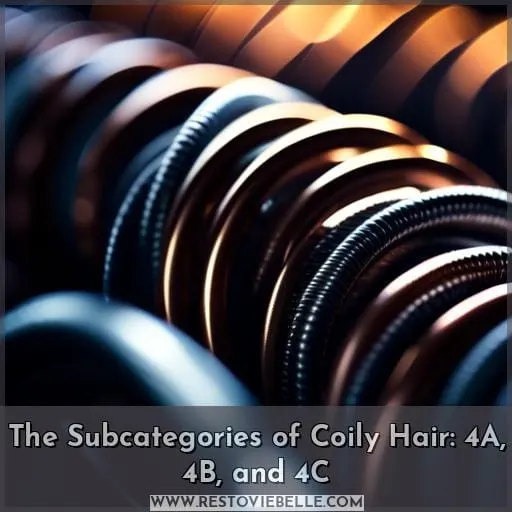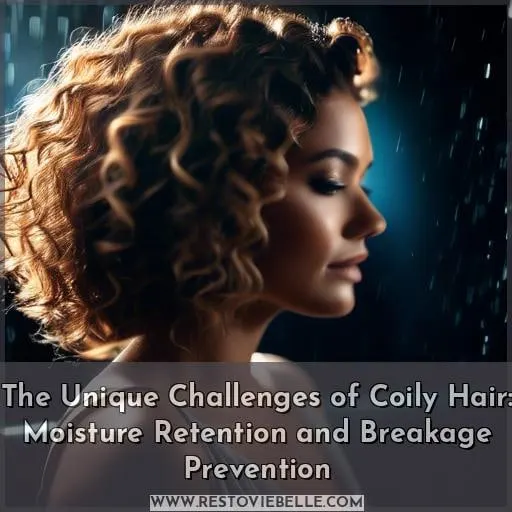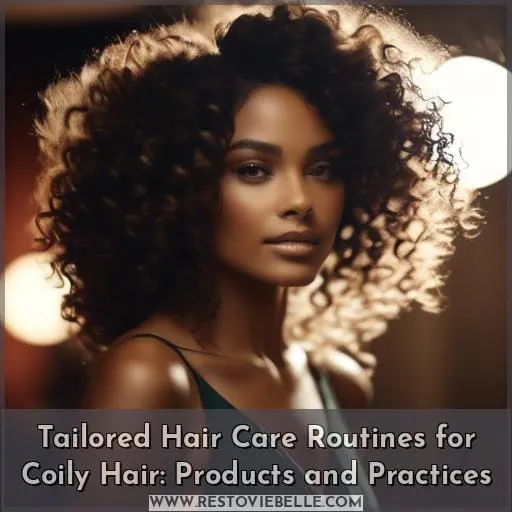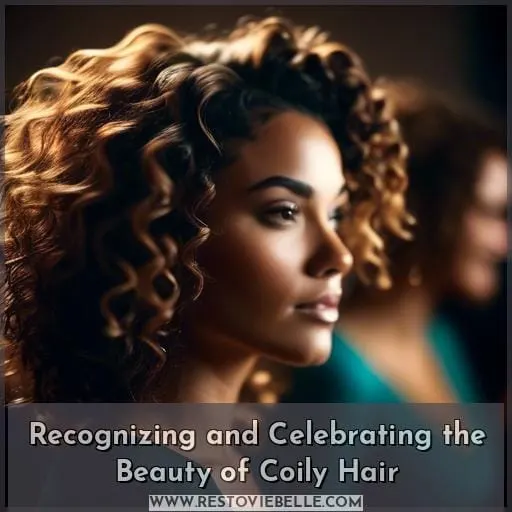This site is supported by our readers. We may earn a commission, at no cost to you, if you purchase through links.
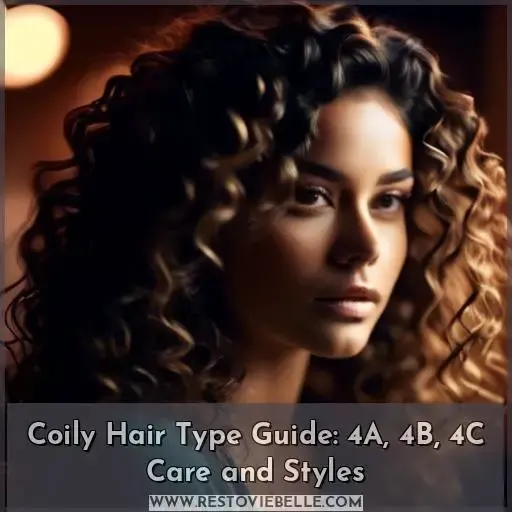 Imagine a garden where each curl is a unique flower, spiraling into its own pattern of beauty.
Imagine a garden where each curl is a unique flower, spiraling into its own pattern of beauty.
That’s the essence of coily hair, a lush landscape of 4A, 4B, and 4C types, each with its own twist and turns.
You’re not just wearing hair; you’re adorned with a crown of intricate patterns that demand tailored care to thrive.
Dive into the world of coily hair, where understanding your unique texture is the key to unlocking a realm of styling possibilities and the ultimate hair care mastery.
Coily hair, also known as Type 4, features strands that form tight curls in a zig-zag pattern from the scalp and is the most voluminous of hair types.
Table Of Contents
- Key Takeaways
- The Subcategories of Coily Hair: 4A, 4B, and 4C
- The Unique Challenges of Coily Hair: Moisture Retention and Breakage Prevention
- Tailored Hair Care Routines for Coily Hair: Products and Practices
- Recognizing and Celebrating the Beauty of Coily Hair
- Frequently Asked Questions (FAQs)
- How does the climate and environment affect coily hair health and maintenance?
- Can diet and nutrition play a role in the health of coily hair?
- What are the genetic factors influencing coily hair characteristics?
- How do hormonal changes affect coily hair throughout different life stages?
- What are the historical and cultural significances of coily hair?
- Conclusion
Key Takeaways
- Coily hair, also known as Type 4, features tight curls in a zigzag pattern and includes subtypes 4A (S-shaped curls), 4B (Z-shaped kinks), and 4C (dense coils).
- Challenges for coily hair include moisture retention, breakage prevention, and the need for gentle styling to minimize damage, with porosity affecting moisture absorption and product selection.
- Tailored hair care for coily hair involves using heat for low porosity hair during deep conditioning, maintaining scalp health, employing protective hairstyles, and using moisture-rich products for frizz control.
- Coily hair is celebrated for its resilience and versatility, serving as a canvas for self-expression and cultural significance, with movements like the CROWN Act protecting against hair discrimination.
The Subcategories of Coily Hair: 4A, 4B, and 4C
Understanding your coily hair’s specific type—4A, 4B, or 4C—is key to unlocking the perfect hair care routine. Each subtype has its unique pattern and challenges, from the springy S-shaped curls of 4A to the tighter Z-shaped kinks of 4B, and the densely packed coils of 4C that can shrink up to 75%.
Your hair’s porosity also plays a crucial role, as high porosity hair, common in coily textures, requires more moisture and protein-based care.
To nurture your coily locks, you’ll need to adopt a regimen that emphasizes moisture retention and breakage prevention. This includes using moisture-rich products, protective styles to shield your hair from environmental stressors, and gentle scalp care to promote healthy hair growth.
Styling techniques should be chosen carefully to minimize damage, and understanding the unique needs of your hair type will help you celebrate and enhance its natural beauty.
The Unique Challenges of Coily Hair: Moisture Retention and Breakage Prevention
Coily hair, with its tight curls and zig-zag pattern, is stunning yet delicate, often facing challenges like moisture retention and breakage prevention.
If you’re navigating these waters, understanding your hair’s porosity is key to selecting the right moisture-rich products that will penetrate and hydrate effectively.
Breakage can be thwarted by adopting gentle styling techniques, minimizing manipulation, and using protective styles to shield your strands from environmental stressors.
Regular protein treatments can reinforce your hair’s structure, while deep conditioning is a must to maintain elasticity and strength.
Tailored Hair Care Routines for Coily Hair: Products and Practices
Caring for coily hair means understanding its unique needs, especially when it comes to moisture and frizz control.
-
Low Porosity Management: Your coily strands may struggle to absorb moisture due to low porosity. Use heat, like a warm towel or a steamer, to open up the cuticles before applying deep conditioners. Opt for lightweight, moisture-rich products that won’t sit on your hair’s surface.
-
Scalp Health: Keep your scalp clean and stimulated to promote growth. Use a gentle, moisturizing shampoo to prevent dryness and incorporate growth stimulators like peppermint oil or scalp massages into your routine.
-
Protective Hairstyles: Embrace styles that tuck away your ends and reduce manipulation. Protective hairstyles like box braids, cornrows, or two-strand twists not only minimize breakage but also help in retaining length. Always ensure they’re not too tight to avoid tension on the scalp.
Recognizing and Celebrating the Beauty of Coily Hair
As you’ve learned to nurture your coily hair with the right products and practices, it’s equally important to embrace the cultural tapestry it represents. Your coily strands are more than just hair; they’re a vibrant expression of history and identity.
Coily hair, with its tight curls and zig-zag pattern, stands as a testament to resilience and versatility. It’s a canvas for self-expression, reflecting personal experiences and societal perceptions.
Historically, coily hair has been a symbol of beauty and strength within the Black community, despite facing societal scrutiny. The historical context of coily hair is rich, with styles like Bantu knots and cornrows carrying deep cultural significance.
These styles aren’t just protective; they’re a celebration of heritage and a form of communication, often indicating one’s background or status.
In recent times, there’s been a shift in societal perceptions, with movements advocating for the acceptance of natural hair textures. The CROWN Act, for example, is a legislative stride towards eradicating hair discrimination, acknowledging the importance of cultural expression through hair.
Your coily hair is a crown, unique to you and your story. It’s a connection to a community that shares similar historical struggles and triumphs. As you wear your hair with pride, you’re not just making a personal statement; you’re honoring a legacy of self-expression and challenging outdated norms.
Celebrate your coily hair, for it’s not just a part of you—it’s a reflection of a rich, enduring culture.
Frequently Asked Questions (FAQs)
How does the climate and environment affect coily hair health and maintenance?
Humid climates can cause your coily hair to frizz and lose definition.
Dry environments may lead to brittleness.
Protect your spirals with moisture-rich products to combat climate effects.
Can diet and nutrition play a role in the health of coily hair?
Yes, diet and nutrition significantly impact coily hair health.
Eating foods rich in vitamins A, D, zinc, and omega-3 fatty acids nourishes your scalp and strands, promoting strong, hydrated curls.
What are the genetic factors influencing coily hair characteristics?
Ye olde genes play a crucial role in your coily hair’s twist and twirls.
Specific genes like TCHH, EDAR, and PRSS53 orchestrate the dance of your curls, with dominant traits often leading the ball.
How do hormonal changes affect coily hair throughout different life stages?
Hormonal fluctuations can transform your coily hair’s texture and growth patterns during puberty, pregnancy, and menopause.
This transformation often leads to dryness and thinning.
What are the historical and cultural significances of coily hair?
Coily hair’s history is a tapestry of triumph and identity, a defiant crown worn through centuries of struggle and celebration.
It’s a cultural beacon, signaling resilience and unity, a symbol woven into the very fabric of Black heritage.
Conclusion
Embrace your coily hair type as a symbol of divine connection and creativity, a crown of spirals that mirrors the strength and resilience within you.
Your journey with 4A, 4B, or 4C hair is unique, requiring moisture-rich care to maintain its splendor.
Cherish your coily strands, for they aren’t merely locks but a testament to your identity and the rich tapestry of your ancestry.

